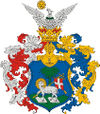Debrecen
| Debrecen | |||
|---|---|---|---|
|
|
|||
|
|||
| Nickname(s): "The Calvinist Rome" | |||
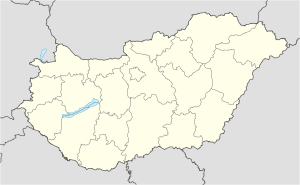 Debrecen
|
|||
| Coordinates: | |||
| Country | |||
| County | Hajdú-Bihar | ||
| Government | |||
| - Mayor | Lajos Kósa | ||
| Area | |||
| - Total | 461.25 km2 (178.1 sq mi) | ||
| Population (2010) | |||
| - Total | 207,270 |
||
| - Density | 442.53/km2 (1,146.1/sq mi) | ||
| Time zone | CET (UTC1) | ||
| - Summer (DST) | CEST (UTC+2) | ||
| Postal code | 4000 | ||
| Area code(s) | 52 | ||
Debrecen (Hungarian pronunciation: [ˈdɛbrɛtsɛn] (![]() listen), known by alternative names),[1] is the second largest city in Hungary after Budapest. Debrecen is the regional centre of the Northern Great Plain region and the capital of Hajdú-Bihar county.
listen), known by alternative names),[1] is the second largest city in Hungary after Budapest. Debrecen is the regional centre of the Northern Great Plain region and the capital of Hajdú-Bihar county.
Contents |
Name
The name was first mentioned by the name "Debrezun" in 1235. Theories say the name is of Cuman origin. In other languages: in Slovak Debrecín, in Romanian Debreţin, in German Debrezin, in Serbian Debr(e)cin.
Location and transport infrastructure
_downtown.jpg)
Debrecen is located on the Great Hungarian Plain, 220 km (137 mi) east of Budapest. Situated nearby is the Hortobágy, a national park within Hungary .
The city used to be somewhat isolated from Budapest, Hungary's main transport hub. However, the new sections of motorway M3 (M35) have already significantly decreased travel times. Also, there have been improvements to the current highway (main road) and modernisation of some parts of the rail tracks between the capital and Debrecen as part of Hungary's mainly EU-funded National Development Plan for 2004 to 2006. Debrecen Airport (the second largest in Hungary) has recently undergone modernisation in order to take more international flights.
In the longer term, Debrecen's proximity to Ukraine and Romania may enable it to develop as an important trade centre and transport link for the wider international region.
For local transport in the city see Public transport in Debrecen.
History
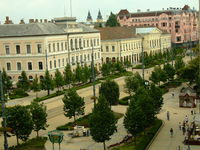
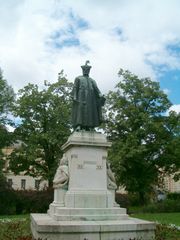
Before Hungarians occupied present-day Hungary, a number of different tribes lived in the area. The town came into existence by the merging of the small villages of the area.
In 1361 King Louis I of Hungary granted the citizens of Debrecen the right to choose the town's judge and council. This opened new opportunities for the town. By the early 16th century Debrecen was an important market town. King Sigismund, Holy Roman Emperor, as part of a treaty with Serbian ruler Despotus Stefan Lazarević, gave him Debrecen as a gift in September of 1411. A year after Lazarević's death in 1426, the lord of Debrecen became Despotus Đurađ Branković of Serbia, Stefan's succesor. Between 1450 and 1507, it was a domain of the Hunyadi family.
During the Ottoman period, being close to the border and having no castle or city walls, Debrecen often found itself in difficult situations and the town was saved only by the diplomatic skills of its leaders. Sometimes the town was protected by the Ottoman empire, sometimes by the Catholic European rulers or by Francis II Rákóczi, prince of Transylvania. This led the town's citizens to be open-minded and Debrecen embraced the Protestant Reformation quite early, earning the moniker "Calvinist Rome". At this period the inhabitants of the town were mainly Hungarian Calvinists. Debrecen became sanjak between 1541–1693 and orderly bounded to eyalets of Budin (1541–1596), Eğri (1596–1660) and Varat (1660–1693) as "Debreçin".
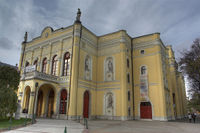
In 1693 Leopold I, Holy Roman Emperor elevated Debrecen to free royal town status. In 1715, the Roman Catholic Church returned to Debrecen, and the town gave them a place to build a church, so the Piarist monks could build the St. Anna Cathedral. By this time the town was an important cultural, commercial and agricultural centre, and many future scholars and poets attended its Protestant College (a predecessor of today's University of Debrecen).
In 1849 Debrecen was the capital of Hungary for a short time when the Hungarian revolutionary government fled there from Pest-Buda (modern-day Budapest.) In April 1849, the dethronization of Habsburgs (neglected after the fall of the revolution) and the independence of Hungary was proclaimed here by Lajos Kossuth at the Great (Calvinist) Church (Nagytemplom in Hungarian.) Debrecen also witnessed the end of the war of independence; the battle in which the Russians, the allies of the Habsburgs, defeated the Hungarian army was close to the western part of the town.
After the war, Debrecen slowly began to prosper again. In 1857 the railway line between Budapest and Debrecen was completed, and Debrecen soon became a railway junction. New schools, hospitals, churches, factories, mills were built, banks and insurance companies settled in the city. The appearance of the city began to improve too: with new, taller buildings, parks and beautiful villas it no longer resembled a provincial town and began to look like a modern city. In 1884 Debrecen became the first Hungarian city to have a steam tramway.
After World War I, Hungary lost a considerable portion of its eastern territory to Romania, and Debrecen once again became situated close to the border of the country. It was controlled by the Romanian army for a short time in 1919. Tourism provided a way for the city to begin to prosper again. Many buildings (among them an indoor swimming pool and Hungary's first stadium) were built in the central park, the Nagyerdő ("Big Forest"), providing recreational facilities. The building of the university was completed. Hortobágy, a large pasture owned by the city, became a tourist attraction.
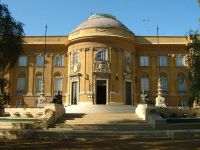
During World War II, Debrecen was almost completely destroyed, 70% of the buildings suffered damage, 50% of them were completely destroyed. A major battle, the Battle of Debrecen, occurred near the city in October 1944. After 1944 the reconstruction began and Debrecen became the capital of Hungary for a short time once again. The citizens began to rebuild their city, trying to restore its pre-war status, but the new, Communist government of Hungary had other plans. The institutions and estates of the city were taken into public ownership. This forced change of the old system brought new losses to Debrecen; half of its area was annexed to nearby towns, and the city also lost its rights over Hortobágy. In 1952 two new villages – Ebes and Nagyhegyes – were formed from former parts of Debrecen, while in 1981 the nearby village Józsa was annexed to the city. The newly built blocks of flats provided housing for those who lost their homes during the war. In the following decades Debrecen was the third largest city of Hungary (behind Budapest and Miskolc), and became the second largest in the 1990s when the population of Miskolc decreased.
Population
| Historical populations | ||
|---|---|---|
| Year | Pop. | %± |
| 1870 | 45,132 | — |
| 1880 | 50,320 | 11.5% |
| 1890 | 56,246 | 11.8% |
| 1900 | 73,878 | 31.3% |
| 1910 | 90,764 | 22.9% |
| 1920 | 101,543 | 11.9% |
| 1930 | 116,013 | 14.3% |
| 1941 | 124,148 | 7.0% |
| 1949 | 115,399 | −7.0% |
| 1960 | 134,930 | 16.9% |
| 1970 | 167,860 | 24.4% |
| 1980 | 198,195 | 18.1% |
| 1990 | 212,235 | 7.1% |
| 2001 | 211,034 | −0.6% |
| 2005 | 204,297 | −3.2% |
| 2010 | 207,270 | 1.5% |
Ethnic groups (2001 census)
- Magyars - 94.7%
- Roma - 0.5%
- Others - 0.8%
- No answer - 4%
Religions [2]
- Calvinist - 38.7%
- Roman Catholic - 15.4%
- Greek Catholic - 8.2%
- Lutheran - 0.5%
- Others - 1.5%
- Atheist - 24.8%
- No answer - 10.9%
Education
Debrecen is home to a large university, University of Debrecen, whose main building is a widely recognized work of architecture. The university has many departments and is a major research facility in Europe. Debrecen is the site of an important choral competition, the Bela Bartok International Choir Competition, and is a member city of the European Grand Prix for Choral Singing.
Sports
The city has a famous football club, Debreceni VSC. It is currently one of the best teams in Hungary, having won the national championship in the consecutive seasons of 2004/2005, 2005/2006, 2006/2007 and 2008/2009. The stadium, which seats more than 10,000, is on Oláh Gábor street, in the City Park (Nagyerdő). The home color of the team is red, while the away color is white.
The city has hosted several international sporting events in the last years, such as the second World Youth Championships in Athletics in July 2001 and the first IAAF World Road Running Championships in October 2006, as well as the 2007 European SC Swimming Championships. In 2002, Debrecen hosted the World Artistic Gymnastics Championships.
The city was an official applicant to host the inaugural Youth Olympic Games in 2010.
Gallery
 Leonardo's Colossus and the MODEM Centre for Modern and Contemporary Art. |
 Street in Debrecen |
 University of Debrecen |
 Coat of Arms |
|
County House |
 Calvinist College of Debrecen (founded in 1538) |
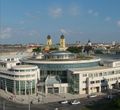 Kölcsey Convention Centre |
 Főnix Hall |
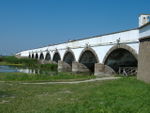 Hortobágy |
 Nagyerdő (Greatwood) City Park, the first Nature Reserve in Hungary |
 University of Debrecen |
 Interior of the Great Church |
 Piac Street |
 Debrecen, Saint Anna Church |
Central Cemetery |
 "Stumpy" Church |
Main sights
- Protestant Great Church (Nagytemplom)
- City Park (Nagyerdő) and spa
- Déri Museum (art collection including paintings of Mihály Munkácsy; also has a collection of Ancient Egyptian artifacts)
- Flower Carnival of Debrecen held on 20 August every year
Famous people
Born in Debrecen
- Ferenc Barnás (born 1959), novelist
- Zsolt Baumgartner (born 1981), first Hungarian Formula One driver
- Mihály Fazekas (1766–1828), writer
- Mihály Flaskay (born 1982), breaststroke swimmer
- Nóra Görbe, (born 1956), actress, singer and pop icon
- Dr. George Karpati (1934–2009), physician, neurologist, surgeon, teacher, author
- Rivka Keren (born 1946), Israeli writer
- Orsi Kocsis (born 1984), fashion, glamour and art nude model
- Imre Lakatos (1922–1974), philosopher of mathematics and of science
- Paul László (1900–1993), architect
- Kocsár Miklós (born 1933), composer
- Magda Szabó (1917–2007), writer
- Mihály Csokonai Vitéz (1773–1805) poet
- Chaim Michael Dov Weissmandl (1903–1957), rabbi and Holocaust activist
- Meshulam Gross (1863–1947), Hungarian-American entrepreneur
Lived in Debrecen
- Endre Ady (1877–1919), poet
- Julia Bathory (1901–2000), glass artist
- Géza Hofi, (1936–2002) stand-up comedian
- Sándor Szalay (physicist) (1909–1987), physicist, founder of ATOMKI
- Árpád Tóth (1886–1928), poet
Twin towns - sister cities
Debrecen is twinned with:
|
Notes and references
- ↑ Alternative spellings used in English include Debreczen and Debrcczin.
- ↑ "2001 Census". http://www.nepszamlalas.hu/eng/volumes/06/09/tabeng/3/load01_10_0-2.html. Retrieved 03-07-2010.
- ↑ [1]
External links
- (English) Official site
- DKV - Public Transport Official Site
- (English) History of Debrecen and Hajdú-Bihar county
- (Hungarian) Hajdu Online - county portal
- (Hungarian) Debrecen Online portal
- Aerial photography: Debrecen
- Tour guide to Debrecen on SeeUinHungary.com
- (English) (German) Tram in Debrecen
- Debrecen photo gallery
|
|||||||||||||||||
|
||||||||||
